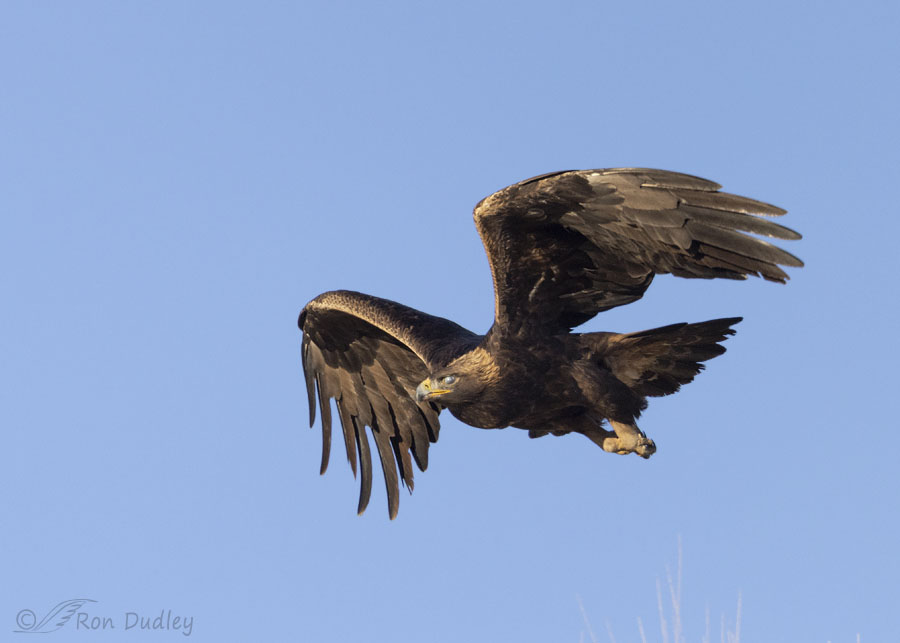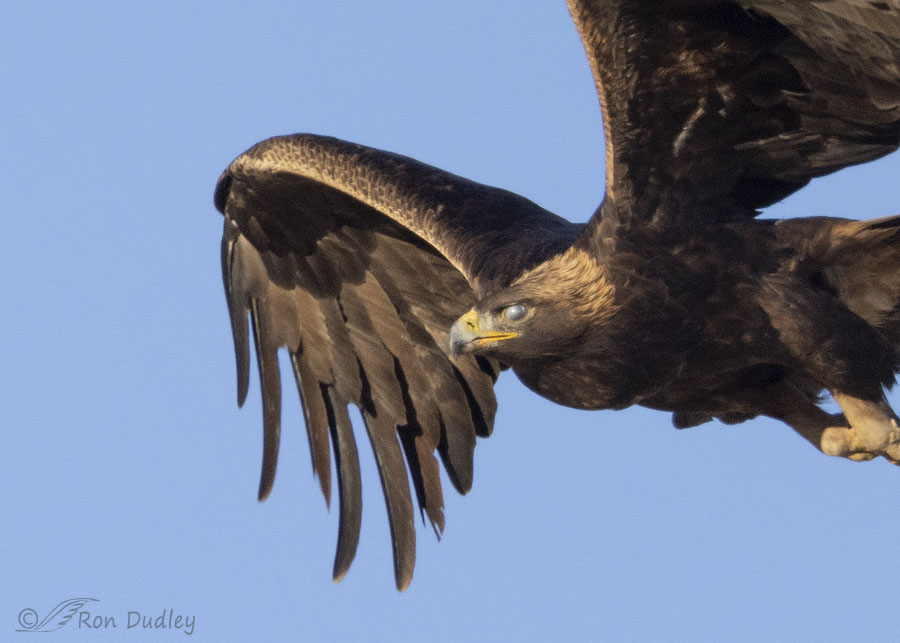I’m often disappointed when the bird in one of my photos that I like otherwise has its nictitating membrane closed. But for a Golden Eagle I’ll make an exception, especially when it’s in flight and I have other photos of the same bird without its membrane showing.

1/5000, f/5.6, ISO 800, Canon EF500mm f/4L IS II USM + 1.4 tc, not baited, set up or called in
Three days ago I got a lot of nice photos of this adult Golden Eagle in flight but until last night I hadn’t noticed that in this one its membrane is closed, resulting in a left eye that appears cloudy. The nictitating membrane is a third eyelid, beneath the other two, that is translucent or partially transparent.
Birds close their membranes briefly for a variety of reasons, including to protect their eyes from wind, dust and hazards and to keep their eyes moist. In this case it’s most likely that the eagle blinked its membrane just to moisten its eye and that’s when my shutter clicked.

I was pleased to see that the image was sharp enough, and I had enough detail, to crop in tightly on the photo for an even better look at the membrane.
I’ve only photographed a Golden Eagle’s membrane twice before and in neither of those images was the eagle in flight, so I thought this photo was interesting enough to share. Most of us have seen the membrane of other birds many times but I’m betting that few have seen it in a wild Golden Eagle.
On the other hand, when discussing forest conservation Ronald Reagan once famously said, “If you’ve looked at a hundred thousand acres or so of trees — you know, a tree is a tree, how many more do you need to look at?”, Those that ascribe to Reagan’s philosophy may think that if you’ve seen one nictitating membrane you’ve seen them all.
I think otherwise.
Ron


Everything about this Golden Eagle photo is intriguing — and after your initial post 2 days ago and this unusual shot, I’m ready to see this bird’s wings, legs and feet fully stretched out so I can be sure everything works properly! 😉
Chris, I’ll try to post a shot like that before too long.
Who knew that I would find another reason to be unimpressed with Reagan.
Another great shot – and some days I would like a nictating membrane of my own.
It could come in handy, couldn’t it EC. Thanks.
No bugs on the “windshield” for that bird! Great shot, Ron. Thank you.
An interesting way to put it. Thanks.
I am glad you had such a productive day while getting out! Sorry an eagle is not an eagle and a tree is not a tree. Anyone who spends time in nature knows there are differences in individual animals and trees. Perhaps that is some our political problems with people. We have different individual opinions and experiences unique to us. A single party line does not define us.
Yup.
Ron,
I don’t know why, but I like the membrane and keep most of my pictures that show it. It takes me back to college days and biology classes. Maybe I was just pleased to see it in person with my camera and actually know what it was! It was one of those “Ah-ha” moments in life when a perhaps trivial piece of knowledge was brought to recollection when I actually encountered it in life.
Anyway…
Stephen
Stephen, in the opinion of this old biology teacher, anything that brings back memories of biology classes is a good thing!
I thought you might feel that way!
I’m glad you are able to get back out “in the field.”
Yet another thing about which to disagree with Ronnie! (And if he really felt the “seen one; seen ‘em all” thing, why did he make so many Bonzo movies?)
I can never tire of looking at trees and I’ll never tire of seeing your Golden shots! I especially like her unusual body position in this shot. I also think catching her nictitating membrane is a pretty cool coincidence!
Good point about his movies, Marty. Thanks.
Lyle’s comment about the lifeless look of even the best sculpture is so spot on! I don’t think I’ll be able to look at a marble head ever again without seeing this eagle’s eye.
Those curled talons somehow make those feet seem even more deadly!
“hose curled talons somehow make those feet seem even more deadly!”
They look like they could club you to death, don’t they Carolyn.
From a purely photographic perspective this photo illustrates the way that the eye and, by extension, the catch light animates a subject. The nictitating membrane evokes the lifeless look that even the best sculpture imparts. Of course, this is a lesson gleaned from the guy who publishes Feathered Photography.
You’re right Lyle and I appreciate knowing that you learned it here. But I did notice that there’s a catch light on the membrane. Not quite the same though…
*shudder* Why did you have to quote him? Lol
The muscles in that bird! I really love the way that gold line shows up in his wings.
“Why did you have to quote him?”
Arwen, partly because I think this particular quote puts him in the appropriate light.
I’m with Michael– I think we need to look closely at EVERYTHING ! Those
who don’t rarely get any surprises, not to mention don’t LEARN anything….until
this morning’s post, it had never occurred to me how vulnerable birds’ eyes
are while they’re in flight–I’m thinking about how a car’s windshield looks
after a long drive……
Kris, lots of things pose a threat to their eyes, especially when they’re going after and subduing prey and, as you say, during flight.
Really captures the membrane – I always wonder if it’s at all disorientating for them when closed for any length of time? Am I imagining it or is the eagle clasping it’s talons?
Judy, its talons are curled which gives the feet a somewhat unusual look.
Excellent photos. If my memory is correct I think it was on your site that I first learned of the nictitating membrane function. Many years back when I first stated taking photos of our eagles I would delete those with their eyes closed and wondered why they were closed.
Interesting to know you remember that Everett.. Thanks.
I agree! Knowledge is key to our survival as a species. Putting one’s head in the sand so you don’t see the trees is a path to destruction. Thanks for continuing to be my favorite teacher.
“Thanks for continuing to be my favorite teacher”
We’ve had that relationship for a very long time, haven’t we Brett. It’s evolved but we still have it.
Wonderful picture Ron. I’m fascinated with nictitating membranes and their usage by our feathered friends. Lovely pic indeed!
Thank you, Rick.
Thanks again Teach! Another learnable moment, and a chance to wonder at nature.
“…how many more do you need to look at?” I think, all of them.
If possible, I think so too. Thanks, Michael.